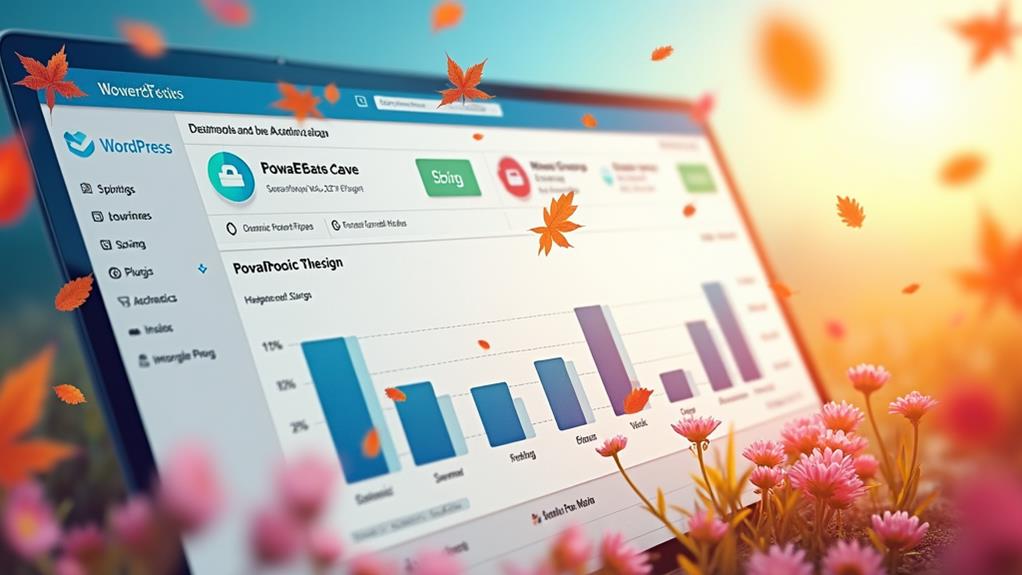Staying relevant year-round with seasonal blogging requires strategic planning and trend awareness. Use tools like Google Trends to identify key dates and peak interest periods. Balance seasonal content with evergreen themes, scheduling posts at least two months in advance. Enhance visibility by optimizing with trending seasonal keywords and incorporating timely topics to engage audiences effectively. Regularly update content based on performance analytics to refine strategies. Consider collaborating with influencers and repurposing content for broader reach across multiple platforms. By implementing these tactics, bloggers can guarantee continuous engagement and discover insightful strategies for further success.
Key Takeaways
- Research and utilize seasonal trends with tools like Google Trends to enhance content relevance and boost engagement.
- Plan content calendars strategically, incorporating key dates and seasonal events to capture peak audience interest.
- Balance evergreen and seasonal content to maintain consistent traffic and audience connection throughout the year.
- Optimize content with seasonal keywords for improved SEO and timely engagement with audience interests.
- Regularly update and repurpose past seasonal posts to keep content fresh and aligned with current trends.
Understanding Seasonal Content
Understanding seasonal content is essential for bloggers aiming to enhance their relevance and engagement in a competitive digital landscape. By aligning with seasonal themes, bloggers can tap into specific audience interests that peak during certain times of the year, thereby increasing user interaction and boosting search rankings.
Seasonal content aligns with time-specific topics and events, allowing bloggers to create timely and relevant posts that resonate with their audience. This alignment often results in higher engagement, as users are more likely to search for and interact with content that matches their current interests and needs.
To effectively leverage seasonal themes, bloggers should research seasonal trends and optimize content with relevant keywords. This strategy not only enhances search engine visibility but also attracts more visitors during peak times.
Additionally, incorporating seasonal topics alongside evergreen content provides a steady stream of ideas, helping bloggers maintain a consistent connection with their audience. Monitoring competitors' seasonal strategies and utilizing tools like Google Trends can offer valuable insights into trending topics, enabling bloggers to capitalize on increased interest and shareability.
Planning Your Content Calendar
In planning your content calendar, identifying key dates such as seasonal events and holidays relevant to your audience is essential for maximizing engagement.
By leveraging trend analysis tools like Google Trends, you can strategically schedule content around peak interest periods, ensuring your posts align with user search behavior.
Additionally, a balanced mix of evergreen and seasonal content tailored to these insights will help maintain consistent audience engagement and traffic throughout the year.
Key Dates Identification
Successful content planning hinges on the strategic identification of key dates that align with your audience's interests and behaviors. Holiday themes and event planning form the backbone of a robust content calendar. Identifying events such as Christmas and Thanksgiving, which are universally recognized, can enhance content relevance. Mapping these events at least two months in advance guarantees your blog captures peak search interest. Integration of trending keywords related to these seasonal events further boosts search engine visibility, drawing organic traffic.
To tailor content, consider monitoring industry calendars and local events, which allows for regional customization and increased engagement. Reviewing past performance metrics is vital; understanding which dates previously generated high traffic enables you to refine future strategies. Here's a simplified snapshot:
| Event/Date | Audience Interest | Engagement Potential |
|---|---|---|
| Christmas | High | Very High |
| Thanksgiving | Moderate to High | High |
| Local Festivals | Varies by Region | Moderate to High |
This table illustrates how the identification of key dates can influence audience interest and engagement levels. Ultimately, a well-planned content calendar, rooted in data and aligned with audience preferences, serves as a powerful tool for maintaining relevance year-round.
Trend Analysis Tools
Harnessing the power of trend analysis tools is essential for crafting a content calendar that resonates with your audience's seasonal interests. By employing tools such as Google Trends, content creators can perform trend forecasting to identify seasonal spikes in interest for specific topics. This data-driven approach guarantees that your content aligns with peak search times, maximizing visibility and engagement.
The integration of data visualization within these tools provides a clear picture of how interest fluctuates over time, allowing for precise planning.
Incorporating platforms like BuzzSumo further refines this strategy by analyzing trending content within your niche. This insight enables you to populate your content calendar with relevant and engaging topics, tailored to your audience's current preferences.
Additionally, social listening tools such as Hootsuite or Sprout Social are invaluable in monitoring ongoing conversations and emerging topics. These platforms provide real-time feedback on what your audience is discussing, guiding the timely creation of seasonal posts.
Regularly reviewing analytics from past seasonal campaigns can also enhance future strategies. By identifying topics that have historically generated high engagement and traffic, you can refine your content calendar to focus on proven successful themes, guaranteeing sustained relevance throughout the year.
Strategic Content Scheduling
Crafting a strategic content calendar is an indispensable component of effective seasonal blogging, enabling bloggers to align their posts with peak search times and audience interests. By planning content themes well in advance, bloggers can guarantee timely publication that corresponds with high search traffic periods around holidays and events.
Scheduling posts at least two months before a seasonal event is essential, as it captures early interest and maximizes audience engagement when search traffic spikes.
Utilizing data-driven tools like Google Trends allows bloggers to pinpoint trending seasonal topics, facilitating strategic content planning. This approach guarantees that posts resonate with contemporary audience interests, enhancing the relevance and reach of the content.
Striking a balance between seasonal and evergreen content in the calendar is critical for maintaining consistent audience engagement. While seasonal content boosts visibility during peak times, evergreen topics sustain traffic and engagement throughout the year.
Regularly reviewing and updating the content calendar based on past performance analytics is another important strategy. This practice refines future content themes, guaranteeing they are aligned with audience expectations and search trends.
Optimizing for Seasonal Trends
Leveraging tools like Google Trends is essential for identifying seasonal trend opportunities and aligning your content strategy with periods of heightened search activity.
By timing content releases strategically through a well-planned calendar, you can guarantee your posts hit when audience interest peaks.
Additionally, adapting your strategies based on competitor insights and engagement metrics allows for continuous refinement and maximizes relevance during key seasonal moments.
Identifying Trend Opportunities
Understanding seasonal trends is essential for maximizing the effectiveness of your blogging strategy. By leveraging trend forecasting and market research, you can identify peak interest periods and tailor your content to align with audience demand. Tools like Google Trends are invaluable for monitoring search traffic spikes around major holidays, providing insights into when specific topics are gaining traction.
Historical data also plays a critical role; by examining past patterns, you can anticipate increased online searches for certain products or services and time your content to coincide with these surges.
To further refine your approach, analyze competitors' seasonal strategies. This can reveal market gaps where your unique content could stand out, offering fresh perspectives or addressing unmet needs. Additionally, engaging with social media trends and seasonal hashtags helps align your content with current audience interests, enhancing shareability and engagement.
Incorporating seasonal keywords into your strategy is another crucial step. This enhances SEO visibility and attracts organic traffic during peak times, ensuring your content is seen by those most interested.
Timing Content Releases
To effectively capitalize on seasonal trends, it is vital to meticulously plan the timing of your content releases. By utilizing precise timing strategies, you can enhance audience engagement and align your content with peak interest periods.
Developing a content calendar that schedules blog posts around significant holidays and events is essential. This proactive approach guarantees that your content is released in harmony with audience searches, optimizing its reach and impact.
Researching seasonal keyword trends with tools like Google Trends allows you to identify when interest in specific topics peaks. Publishing your content 2-4 weeks ahead of these peaks enables you to leverage search traffic and maximize audience engagement.
Additionally, monitoring competitor strategies can provide insights into emerging seasonal trends, allowing you to adjust your content plan to remain competitive.
To further refine your timing strategies, consider the following:
- Develop a content calendar: Schedule posts around key holidays and events.
- Utilize keyword research tools: Identify peak search times and plan accordingly.
- Publish in advance: Aim for 2-4 weeks before peak interest periods.
- Analyze competitor strategies: Stay informed on emerging seasonal trends.
Regularly analyzing the performance of your seasonal posts will help refine your approach, guaranteeing sustained relevance and audience engagement year-round.
Adapting Strategies Seasonally
Adapt your blogging strategies to seasonal shifts by keenly observing and capitalizing on current trends. To effectively optimize for seasonal themes, start by monitoring Google Trends. This tool is instrumental in identifying emerging seasonal keywords and topics that resonate with audience preferences. Aligning your content strategy with these insights can notably enhance search engine visibility during peak times, driving more traffic to your blog.
Creating a content calendar is another vital step. By scheduling posts around key seasonal events and holidays, you guarantee timely and relevant content that captures audience interest. This approach not only meets audience preferences but also positions your blog as a go-to resource during these periods.
Incorporate seasonal graphics and imagery to visually enrich your posts, making them more engaging and aesthetically aligned with seasonal themes. Additionally, updating and revitalizing existing seasonal posts can help maintain relevance and leverage historical traffic spikes, potentially increasing views and engagement.
Lastly, engage your audience with seasonal contests or interactive elements. These initiatives encourage participation, foster a community sense, and enhance reader loyalty. By integrating these strategies, bloggers can adapt effectively to seasonal trends and remain relevant year-round.
Engaging With Timely Topics
Engaging with timely topics is a strategic imperative for bloggers aiming to enhance audience interaction and content relevance. By leveraging tools such as Google Trends, bloggers can monitor current events and seasonal trends to achieve timely engagement. This data-driven approach helps identify spikes in search traffic before major holidays and events, informing content creation strategies that align with audience interests.
Crafting seasonal content that resonates with current experiences not only improves relevance but also fosters audience interaction.
To maximize the impact of timely topics, consider these strategies:
- Plan Ahead: Integrate timely topics into your content calendar to guarantee strategic publishing when search interest peaks.
- Utilize Social Media: Share seasonal content on platforms where timely topics naturally generate higher interactions and shares.
- Influencer Collaboration: Partner with influencers or industry experts to amplify reach and credibility, as they bring an audience already aligned with current trends.
- Monitor Trends: Regularly track tools like Google Trends to stay ahead of upcoming seasonal spikes and adjust content strategies accordingly.
Measuring Seasonal Success
Measuring seasonal success is vital for bloggers seeking to refine their content strategies and enhance audience engagement. By conducting thorough traffic analysis during seasonal campaigns, bloggers can uncover valuable patterns in visitor behavior. Identifying traffic spikes linked to particular seasonal topics can help determine which themes resonate most with audiences, enabling more focused and effective content planning.
Engagement metrics such as likes, shares, and comments are also significant indicators of success. These metrics offer insights into audience preferences, providing a clearer picture of what content fosters a deeper connection and builds brand loyalty. High engagement rates signify that content is not only reaching its target audience but also prompting interaction, further boosting visibility and outreach.
Furthermore, conversion rates from seasonal content offer a quantitative measure of effectiveness. Posts that drive significant conversions, such as sales or sign-ups, demonstrate the tangible impact of well-executed seasonal strategies.
In addition, monitoring search rankings for seasonal keywords allows bloggers to evaluate the SEO performance of their content.
Balancing Seasonal and Evergreen
Balancing seasonal and evergreen content is vital for bloggers aiming to optimize their traffic consistency and audience engagement throughout the year. By integrating evergreen posts with seasonal content, bloggers can guarantee a steady flow of visitors while capitalizing on timely trends.
Evergreen integration reduces the risk of content becoming outdated, maintaining relevance across different seasons. This strategy aligns seasonal synergy with foundational topics, enhancing overall SEO performance and user experience.
A well-planned editorial calendar is imperative for scheduling seasonal content in advance while keeping slots open for evergreen pieces. This strategic mix caters to a diverse audience, assuring continuous engagement and relevance.
Regular updates to evergreen content with seasonal insights can breathe new life into existing posts, leveraging current trends to boost traffic and improve search engine rankings.
To maintain a balanced content strategy, consider the following:
- Integrate related seasonal topics with evergreen posts: Link timely articles to foundational resources to guide readers.
- Schedule content strategically: Use an editorial calendar to plan seasonal and evergreen posts efficiently.
- Update evergreen content regularly: Incorporate seasonal trends to keep posts relevant.
- Enhance SEO through synergy: Link complementary seasonal and evergreen content to improve visibility.
Repurposing Seasonal Posts
Frequently, bloggers overlook the immense potential of repurposing seasonal posts, yet data indicates that updating such content can considerably amplify traffic. For instance, revitalizing an article that initially attracted 5,000 views could boost its reach to 15,000 or even 30,000 views upon subsequent reposts. This substantial increase underscores the power of a strategic content refresh.
By aligning titles, images, and statistics with current trends, bloggers can guarantee their material remains engaging and relevant for their audience, thereby enhancing audience engagement.
Repurposing seasonal content also presents an opportunity to create recurring value through seasonal FAQs. This approach not only addresses common audience queries but also fosters ongoing engagement. Moreover, updating existing articles with fresh insights or tips not only saves time and resources but also leverages the established SEO benefits of the original post. This practice maintains the content's relevance and guarantees it continues to attract traffic.
Additionally, repurposed seasonal content can be adapted for various platforms. Transforming a blog post into a video or infographic can extend its reach and impact, engaging a broader audience and maximizing the content's potential across different media channels.
Frequently Asked Questions
How Can I Maintain Audience Interest During Off-Peak Seasons?
To maintain audience interest during off-peak seasons, employ content repurposing to maximize existing materials' value and analyze audience engagement metrics to tailor new content. Stay trend-aware by leveraging current data insights to enhance relevance and engagement.
What Strategies Help Overcome Seasonal Motivation Fluctuations in Blogging?
To overcome seasonal motivation fluctuations in blogging, employ strategic content planning and utilize engagement techniques. Analyze audience data to identify trends, ensuring content remains relevant and engaging. This approach fosters sustained interest and aligns with audience expectations year-round.
How Do I Build a Supportive Blogging Community Year-Round?
To build a supportive blogging community year-round, prioritize community engagement and leverage networking opportunities. Analyze audience data to tailor interactions, participate in trend-aware discussions, and consistently collaborate with like-minded bloggers to strengthen connections and sustain engagement.
Are There Tools to Help Identify Upcoming Seasonal Blogging Trends?
Yes, tools like Google Trends and BuzzSumo facilitate trend analysis and keyword research, enabling bloggers to identify upcoming seasonal trends. These platforms provide data-driven insights, helping bloggers tailor content to align with audience interests effectively.
How Can Personal Experiences Be Integrated Into Seasonal Content?
Integrating personal anecdotes into seasonal storytelling enhances engagement by creating relatable content. Utilizing data analytics, identify audience preferences and align personal experiences with trending seasonal topics to craft compelling narratives that resonate and maintain audience interest year-round.
Conclusion
In summary, maintaining a year-round relevant blog requires an astute understanding of seasonal content, strategic content calendar planning, and optimization for seasonal trends. Engaging with timely topics enhances audience connection, while measuring seasonal success provides data-driven insights for improvement. Striking a balance between seasonal and evergreen content guarantees sustained engagement. Additionally, repurposing seasonal posts maximizes content value. By aligning content strategies with audience preferences and emerging trends, bloggers can achieve sustained relevance and impact throughout the year.




